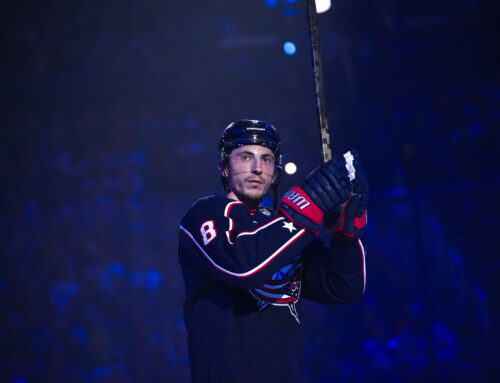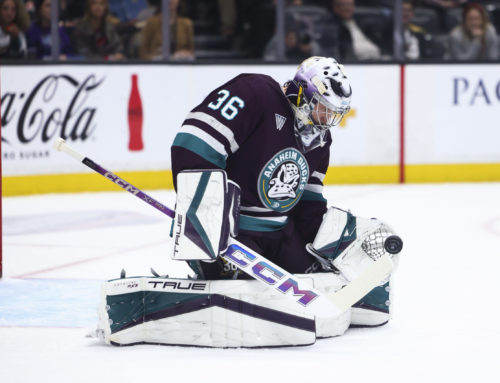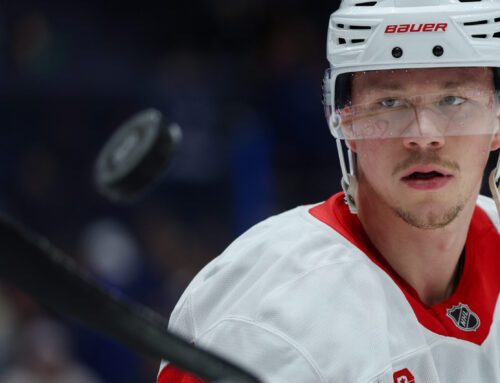
After dominating most of Game 1, Winnipeg didn’t look quite the same team in Game 2. Either that, or Vegas really brought their speed that we’ve been seeing from them all year. Maybe a little from both columns. Either way, Vegas managed to take Game 2 and even up the series at one apiece.
David Perron was a late scratch for the Golden Knights, replaced by Tomas Tatar. And it was Tommy Taters who started the scoring for Vegas, jamming in his own rebound on the short side in the middle of the first period. A few minutes later, Jonathan Marchessault took advantage of a neutral zone turnover from Kyle Connor and made it 2-0. Marc-Andre Fleury held down the fort in the 3-1 win, stopping 30 of the 31 shots he faced. A squeaker under the arm from Connor was the lone blemish. Marchessault added a second goal in the third period to salt the game away.
The final score was almost kind to the Jets. By my count, Vegas hit the iron on three separate occasions (to be fair, the Jets got one of their own). Winnipeg got their own opportunities but it’s not as if Fleury had to stand on his head. This was a good defensive game from the Golden Knights.
This series is shaping up to be a very, very good one.
*
Nashville had their locker-clearing day on Monday and there were a few interesting nuggets to come out, as there usually are on these days.
First, as mentioned in a Ramblings last week, it may not be a lock that Eeli Tolvanen is a lock for top-6 minutes next year. That would put his fantasy value in a state of uncertainty for now. In fact, if coach Peter Laviolette is to be believed, he’s not even a lock for the roster:
#Preds HC Laviolette alludes to the fact that Eeli Tolvanen will need a big summer of training and development to make the team next season. "I'd love nothing more."
— Thomas Willis (@TomAWillis) May 14, 2018
I wouldn’t read all that much into it, at least in the sense of him not developing as they’d hoped. The NHL is littered with young stars who spent some time in the AHL and are now significant contributors. Just look at playoff teams remaining with players like Kyle Connor, Ondrej Palat, Tyler Johnson, and William Karlsson. There is no doubting the wealth of skill Tolvanen possesses but it seems at least the coach wants to pump the brakes a bit. It could just be coach-speak to downplay a guy who plays his way on the roster in four months.
On top of this, Mr. Willis reported that both Alexei Emelin and Scott Hartnell will not return next season. The former makes a lot of sense, the latter I’m not so sure on. The 24 points in 62 games may not look sexy on the surface, but Hartnell was third among their forwards in goals per 60 minutes at five-on-five and fourth in primary points per 60 minutes and he was just above break-even in adjusted shot share relative to his teammates. That’s a pretty good season from a third/fourth liner making $1-million. Maybe it was a mutual thing and he’s looking for a bigger role somewhere else. Whatever the reason, it looks like he still has something left in the tank and could help another team next year. If he can get some decent power-play time somewhere, he could return to fantasy relevance in multi-category leagues.
Finally, Ryan Hartman is expected to undergo shoulder surgery and will be out 4-5 months. At best, he’ll be back in the middle of training camp and at worst he’ll miss the start of next season. I’m a big believer in his skill set being valuable in fantasy leagues if given a proper role but this injury is a concern. I really don’t like relying on players coming off significant offseason surgeries. It’ll be a wait-and-see approach as next year draws closer as far as fantasy relevance goes.
I should add that GM David Poile shot down the PK Subban trade rumours. They never really made sense to begin with considering he was their go-to blue liner in the playoffs and is a Norris Trophy finalist.
*
Vancouver Canucks fans, take a breath:
Pettersson will have surgery on his thumb, be out a few weeks. A minor and routine surgery, will be 100% healthy at training camp, #Canucks
— Rick Dhaliwal (@DhaliwalSports) May 14, 2018
While a completely full offseason of training would be ideal, if he can get back to work in early June, there should be no real cause for concern. You can all rest easy.
*
Big news out of the United States on the sports betting front:
The Supreme Court has just ruled 7-2 to overturn the federal ban on sports gambling. It's a historic day in American sport.
— Brian Windhorst (@WindhorstESPN) May 14, 2018
📢 advertisement:
If you want to read a bit more on this, click here. In short, with the federal ban lifted on sports betting lifted, it may be up to individual states whether to legalize it or not. It can still be banned through Congress, so I really do recommend reading that story I just linked because I’m not an expert on American domestic policy. But it does appear that for you readers in America, it may be legal to bet on NHL games here in the near future. Not only would that apply to brick-and-mortar casinos, but online ones, as well as the expectation that daily fantasy sites like DraftKings will move into this sphere as well.
Aside from the direct result of the lift of the ban, there could be additional benefits. My hope is that there is smarter analysis of the games from both a mathematical and tactical perspective. With more people (hopefully) tuning in because they have money on the games, maybe there is less “nice guy, tries hard, loves the game” analysis and more in-depth features like breaking down win probabilities, goals added/lost through play and deployments, and a bevy of other things. That is my hope, anyway. The NHL is always years, if not decades, behind every other sports league when it comes to smart analysis so this could be a bridge too far. Companies would do well to seek out smart people to hire rather than relying on their current talent to occupy that space. There should be concerns about disseminating bad or misleading information. Hopefully these companies do the right thing.
This was the NHL’s official statement on the matter, which was a long way of saying nothing in particular:
Statement from the National Hockey League regarding today’s Supreme Court decision: https://t.co/YkvtqiM0OG pic.twitter.com/e48y9Bna12
— NHL Public Relations (@PR_NHL) May 14, 2018
*
With that phantom high-stick call on Sunday night that led to a Tampa Bay power-play goal there was some talk on social media for video review of high-sticking calls.
Here’s the thing: that’s a bad idea. It seems like common sense; a high stick is a black-and-white call that can be difficult to discern in real time. Having video review for this seems like a no-brainer, right?
Well, are you sure you want to go down that road? Most penalties are black-and-white. If you jam your stick into a player’s feet and he falls, it’s tripping. If you raise your stick parallel-ish to the ice and pull on a player’s waist, hands, or stick, it’s hooking. If you raise your stick parallel-ish to the ice, with your hands separated on the shaft of your stick, and forcefully apply it to an opponent, that’s cross-checking. If you impede the progress of any player without the puck, that’s interference. And yet, every game, we see dozens of instances where a slight tug on the waist, cross-checks in front of the net or in the corner, or pick plays and slowing a forechecker by skating in front of him do not get called. They happen all the time, in every game. Why stop at video review for high-sticking? These are all penalties as well. The referees just choose not to call them.
The sentiment here is to get the calls right. And that’s usually a noble endeavour. But in this instance, I can’t help but feel we should keep Pandora’s Box shut.
*
This was a weird year in the NHL. Team shot rates (31.8 per team per game) was tied for the fifth-highest since they started tracking shots in the mid-1950s, and the highest they’ve been since the early 1970s. Power-play conversion rates were their highest since 1990. The game is changing and there is a lot of work to be done in figuring out just how (and more specifically by how much) everything is changing.
Shot rate is something mentioned above and is something I’m going to discuss all week. At the team level, at the player level, by position, and by strength.
My first inclination is that with the boom in power-play opportunities, specifically early in the year, that the five-on-five shot rates may not have changed too much. As with many gut assumptions, this was incorrect. Shot rates increased in 2016-17 after a few years in a lull and really exploded this year (data from Natural Stat Trick):

The shot rate is something I’ve discussed before but I assume not every Dobber reader reads everything I write (and hopefully there are a few new ones out there, too). Regardless, shot attempts per team per 60 minutes at five-on-five have increased 6.28 percent over the last two seasons. That may not seem like a lot, but consider that the average amount of five-on-five ice time for a team in a game in 2017-18 was 48.32 minutes. At an average increase of 3.40 shot attempts per 60 minutes, that’s an extra 2.74 shot attempts per team per game. Over the course of a season, the average team would take an extra 224.53 shot attempts. With 31 teams, that’s an extra 6960.05 shot attempts in the entire league at five-on-five. In 2017-18, teams scored on 4.16 percent of total shot attempts at five-on-five (4903 goals on 117 750 shot attempts). Applying that 4.16 shooting percentage to the extra 6960.05 shot attempts, that’s an extra 290 goals at five-on-five league-wide. That’s a lot.
So what does this mean for fantasy? Well, middling shot and goal totals don’t mean what they used to. Hockey Reference’s Play Index shows that there were 118 players who scored 20 goals last year. In 2014-15, just two years ago, there were 105. In 2013-14, there were 101. With more goals, and more middling production, there is less value in those types of producers. Saying “he’s a 20-goal scorer” just isn’t as valuable as it was even 24 months prior.
The same goes for shots. There were 65 players with at least 200 shots in 2013-14. In 2017-18? That number was 87. The number of 200-shot players has gone up over 25 percent in four years. That’s an enormous increase. Again, as with goals, with the increase of middling players with regards to shot production (I don’t mean to use middling disparagingly here, by the way), the value of those middling players declines.
As mentioned earlier, I will go deeper on this topic in the coming days. I already discussed power-play goal scoring from the blue line last month so you can read that here if you haven’t already. But the quicker you can change the way you think about certain benchmarks in fantasy, the bigger edge you’ll have on your league mates.





 FLA
FLA EDM
EDM MTL
MTL ANA
ANA VGK
VGK DET
DET BUF
BUF SEA
SEA COL
COL N.J
N.J BOS
BOS
